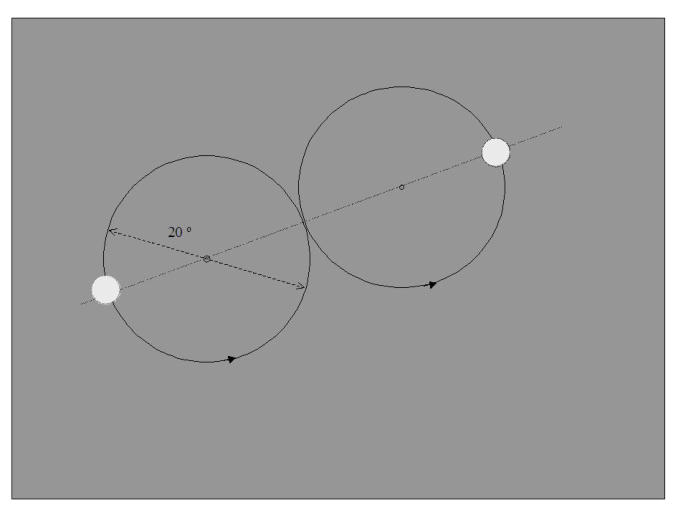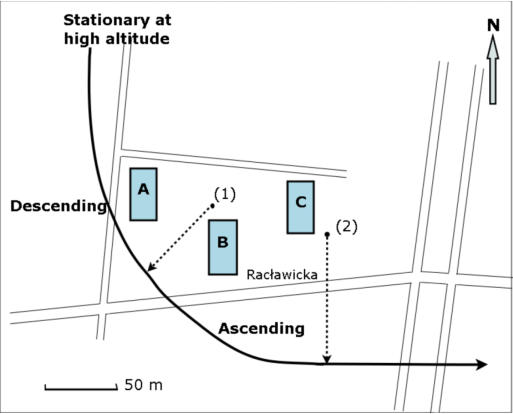

Displays
Extraterrestrial Lights in Warsaw in 2012
Location: Warsaw, Poland, position: 52º12’23’’N, 21º00’53’’ E
3rd floor flat, west facing balcony, 12 m above the ground.
Date: 3 July 2012, 23.00-23:30 (GMT+1)
Click on the link below for narrative and illustrations

![On 3rd of July 2012 at about 11:00 o’clock at night I heard the sound of distant thunder. When I approached the balcony door to close it I stopped and looked up at the lightning. Just by chance, right above me in the sky, I noticed a moving spot of white light. At first I thought that this could be the reflection of car headlights from the low clouds, but when denser cloud passed underneath the spot of light it disappeared. This meant that the light could not originate from the ground but from above the low cloud. The layer of clouds was quite thick and uniform and no stars were visible through it. The base of the clouds was at a height of approximately 400 m (1200 ft) and was illuminated by the street lights. The spot of light was not very bright and its intensity was too low to take a photograph. The clouds moved with a velocity of about 5-10 m/sec pushed by a westerly wind. A description of the spot of light The spot of light was moving with a constant speed in the anticlockwise direction on a circular path which was about 20º in diameter. (Figure 1). It took about 20 seconds to complete one revolution. The centre of the circle was about 70º above the horizon. The spot of lights diameter was about 3-4 times larger than the Moon (1.5 - 2º), but it did not have sharp edges. Its brightness was not uniform, being brightest in the centre, and its edges were blurred like car headlights in a dense fog. Whilst travelling along its circular path the spot of light changed its shape depending on the structure of the clouds. Where the cloud had a uniform density, the shape of the spot was round. However where the clouds density was not uniform, the spot could be oval, jagged, or completely irregular with narrow, spiky light rays radiating in horizontal directions from it. Where the cloud was very dense the light could completely disappear. I then noticed a second spot of light, very similar to the first, which was also moving along a circular path which was touching the first spots circular path (see Fig. 1). The second spots circular path had the same diameter as the first path and was positioned to the right and above the first path. Its centre was about 80º above the horizon meaning that the centres of both circles were not in a horizontal line. The second spot was also moving along its path in an anticlockwise direction, with the same speed as the first spot. Both lights always met at the same point, where the two circular paths touched each other. At this point the lights were fully overlapped in such a way that only one spot was visible. The movements of both spots were perfectly synchronized at all times during the observation. The shape of the second light spot changed in a similar way to the shape of the first light spot, but in a given moment of time the shapes of the spots were not identical because the lights were passing through different cloud areas. When the clouds were uniform, both lights had a similar circular shape. Since the lights were moving along perfect circular trajectories as seen from the ground, these trajectories were not in the same plane but in two different planes at about 20 degrees to each other. Fig. 1. Geometry of the circular motion of the spots of light Light source position The most likely source of the light would have to have been in the shape of a sphere radiating rays in all directions. Therefore the brightness of the spot of light when viewed from underneath the cloud was not uniform. After analysing the shapes of the spots I reached the conclusion that the sources of the lights must have been in the lower layer of the clouds, otherwise the light would not be visible if positioned above the thick clouds. Also, if the sources of the spherical lights were positioned above the clouds its skew light rays would be much less attenuated than if the source was placed in the cloud of the same thickness, therefore the spot of light would have a much larger diameter. This was confirmed by an observation of the Moon light shining through the clouds resulting in a very large light spot diameter. Another observation which confirms the assumption that the light source was placed in the lower part of the clouds was the propagation of irregular light rays from the centre of the spots in the approximately horizontal direction. Any light source placed above the clouds would not be able to generate horizontal rays visible from the underneath of the clouds. Movement of the light source Assuming that the lights were about 400 m above the ground, the two spots of light had a diameter of about 14 m and moved with a constant speed of 22 m/sec. The diameters of both the trajectories were about 140 m. The spots moved with high precision because the intersection point during the observation was always in the same place. The trajectories overlapped so perfectly that only one spot was visible at the intersection point. The light of the moving spot was generated by some sort of a light source which had a certain mass and dimensions. Therefore the following forces must have acted on the moving light source; Constant gravitational force. FG = m x g Where m is the mass of the source, g is the gravitational acceleration Constant centrifugal force Fc = m x V2 / r Where m is the mass, V is the velocity of the spot, r is the radius of the circular path Variable air pressure force Fp = P x A Where P is the air pressure and A is the cross section area of the light source Where P = ½ x (density of air) x (air velocity)2 x (drag coefficient) air velocity = Modulus [vector of the light source velocity + vector of wind velocity] The drag coefficient for a sphere is 0.47 The air pressure force acting on the light source depends on the source velocity and the wind velocity. The wind velocity is varying in a range 5-10 m/sec and its direction with reference to the direction of the light source velocity is also variable. The density of air is also variable because the object was travelling through clouds having 2-3g/m3 of water. In spite of several forces, some of them highly variable and unpredictable, acting on the source of the lights, their movement shows very good stability. In spite of the blowing wind the position of the light trajectories did not change for at least 30 minutes. The speed of movement was constant in spite of varying air pressure because the lights met at exactly the same point in the sky. To secure constant speed under these variable conditions you would need a special propulsion system. The propulsion had to be well controlled because the air resistance of the light source was varying all the time. The most interesting question is how to balance the gravitational force. To keep the light source at the constant altitude requires very well controlled vertical propulsion. The centrifugal force acting on the light source had to be compensated by propulsion to keep the source on a perfect circular trajectory. In my opinion we have to exclude the existence of any rigid structure because of the large diameter of the trajectories. Holding any mechanical structure would require an even more sophisticated means of propulsion. To secure the correct movement of the light source there are needed 3 independent propulsion systems providing forces operating in the direction of the 3 axes and controlled with very high precision. Would sensors also be needed measuring speed and position with reference to the ground or other celestial bodies? Also needed is a advanced control system providing synchronisation between the two lights movements. Using existing space technology it would be possible to construct propulsion systems which could move as the two lights did, but it would require two very complex control systems. So far these systems have operated in a vacuum and zero gravity. Operation of such a system in the Earth atmosphere would be several orders of magnitude more difficult than the operation in the space environment. Such a large propulsion and control system would be even more affected by the atmosphere and gravity requiring an even more complex control system. Another possible solution would be to use the existing drone technology. However securing a perfect circular movement, and stabilising and synchronising the movement of two drones in the presence of wind and gravity is practically impossible. This solution is rejected because no slightest noise was detected during the display. One could draw the conclusion that it would be practically impossible to build such a propulsion and control system using the existing technology.](index_htm_files/6147.png)




Lorem Ipsum Irure magna irure,
exercitation minim

© Ut duis incididunt ex officia
Gallery


- Home
- wearenotalone
- downloads
- blogs
- info
- About
- gur
- the new
- interviews
- fatima
- displays
- ancientcivilizations
- religion
- religion
- monotheistic
- apparitions
- where are they
- 20th century
- delivery of water
- arising of life
- damer and deamer
- reviews tng
- reviews2
- reviews3
- polish welcome
- gurdjieff a new int
- not alone review and inter
- polish gurdjieff a new int
- polish gur enigma
- polish czy jestemy
- polish czy jestemy recenzje
- polish czy jestemy publikacje
- polish nova gen
- polish nova gen recenzie
- polish nova gen publikacje
- polish blogi
- polish o autorze
- polish kontakt
- polish pliki
- wywiad













